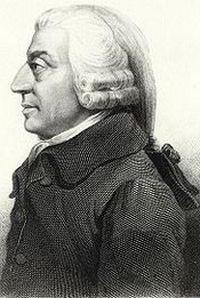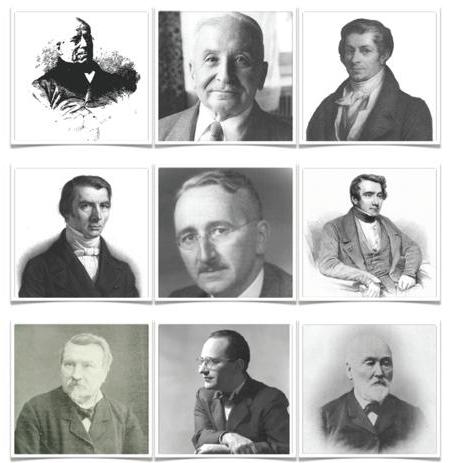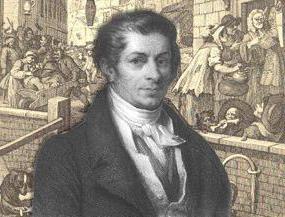Jean-Baptiste Say, whose photo will be presented in the article, is considered one of the prominent followers of the theory of A. Smith. This figure absolutized ideas about the spontaneous mechanism of managing in market conditions. Let us consider further what Jean-Baptiste Say is famous for.
Biography
The leader was born on January 5, 1767 in Lyon, in the family of a merchant, which a priori suggested that he had such a trait as entrepreneurial ability. Jean Baptiste Say, after receiving sufficient education for his time, began to engage in self-education. However, he was influenced by the concept of Smith. The main direction that attracted him was political economy. While studying discipline, he read Smith's work, The Wealth of Nations. The ideas proclaimed in this work should have been disseminated not only for the good of all France, but also the whole world, - so said Jean-Baptiste Say. The economic views of the activist were formed to a greater extent under the influence of the events of the late 18th - early 19th centuries. A significant role was played by his trip to England. In this country, unlike France, industrial tasks began to come to the fore not agricultural ones.
Start of activity
Returning from England in 1789, Say joins an insurance company. There he becomes Secretary of Clavier, who will subsequently become Minister of Finance. It should be noted that the future official was studying Smith’s Wealth of Nations at that time. After 3 years, Jean-Baptiste Say adjoins the Jacobins, goes as a volunteer in the army of revolutionaries. In 1794, he leaves the service, becomes the editor of a Paris magazine and works like this until 1799. His independence and originality, a critical assessment of government activities in the economic sector contributed to his quick and successful career as a member of the Tribunan Finance Committee. The practical experience of working in the state apparatus, his deep knowledge of scientific developments, combined with his perception of Smith's concept, undoubtedly contributed to his writing of his own works on the basis of the theory of improving the social economy.
Jean-Baptiste Say: A Treatise on Political Economy
This work is more of a national importance. In the mid-18th century, physiocratic theories began to emerge in France and soon gained great popularity. They continued to occupy leading positions in the country's economy, despite the fact that in 1802 a translation of "The Wealth of the People" was published. It was Jean-Baptiste Say who managed to overcome the established stereotypes of compatriots. In short, his book became a simple exposition of the way in which the formation, distribution, and consumption of wealth occurs. This work only at first glance repeated and interpreted Smith's ideas. After the publication of the book, Jean-Baptiste Say himself, as well as his colleagues in England, continued to work on improving this work. The publication has undergone repeated additions and alterations. During the life of the activist, the publication of the book took place five times. Work on it turned her into the best work of the time.
Principles of Methodology
Jean-Baptiste Say, like other classics, built his concept on the example of exact sciences. For example, physics was taken as a sample. In methodological terms, this means recognition of categories, laws, and theories that have primary and universal meaning. At the same time, according to Say’s idea, political economy acts as a theoretical and descriptive phenomenon. The activist unconditionally accepted the principles of market freedom, foreign and domestic trade, pricing, unlimited competition and the inadmissibility of even the smallest manifestations of protectionism. He raised these ideas to an absolute rank. When adopting the concept, Sei guaranteed society an objective elimination of overproduction, under-consumption. That is, in fact, in his ideas, he excluded the possibility of crisis phenomena.
Reproduction theory
In the history of economic doctrine, the name of Say is usually associated with the image of a scientist who believed in the harmony of interests of different social classes in market conditions. He preached for her approval the principles of Smith on the self-regulatory economy. It should be said that the criticism of the ideas put forward by Jean-Baptiste Say, despite the large number of attempts to refute them by different figures, remained unconvincing for more than a century. Such stability of the concept was due to three circumstances. First of all, Smith's “natural order” implied flexibility in wages and prices. With the passive role of finance, the exchange of labor and its results between all market entities was mutually beneficial. According to this concept, Jean-Baptiste Say said that a different order is simply unacceptable. Secondly, based again on Smith's ideas, he excludes any interference with outside business. The Say Law supports the requirement to minimize the bureaucratic state apparatus and prevent protectionism. In addition, the concept predicts progression in the development of market relations in society based on the results of scientific and technical progress.

The essence of the "law"
It consisted in the fact that when members of society achieve and subsequently observe all the basic principles of economic liberalism, supply (production) will provoke adequate demand (consumption). That is, the release of products will stably generate income for which the goods will be freely sold. So the "Say Law" was perceived by all supporters of the idea of economic liberalism. They believed that free and flexible pricing in market conditions would provoke an almost instant reaction to changes in the economic environment. This, in turn, would be a guarantee of self-regulation in the economy. In fact, if we assume the likelihood of barter relations in which money acts only as counting units, and the aggregate demand for them is equal to the value of all goods to be exchanged for financial assets, then general overproduction is impossible. From this, the conclusion of Blaug becomes logical and understandable. It consisted of a simple clarification of the law that Jean-Baptiste Say had derived - "products are paid for products" - in both foreign and domestic trade. This thought made a real sensation at that time.

Criticism of Karl Marx
This figure considered himself the successor of ideas not only of Smith, but also of Ricardo. Karl Marx especially sharply exposed the thoughts of the latter and those who shared Say's concept of the impossibility of crises in the economy. He proved the inevitability of cyclical (periodic) phenomena of overproduction. In addition, Marx considered it unacceptable to interpret economic crises as problems of underconsumption. Along with this, problematic phenomena, according to modern conceptual provisions, are caused not so much and not only by the unreliability of Say's ideas, but by the natural prerequisites for the emergence of conditions for the priority of imperfect competition and the spread of monopolism. These categories underlie the theories of state regulation of the economic sector that exist today, and social control over its development.
Three factors of production
Say's economic ideas were definitely supported and reflected in the works of Malthus. For example, his rather widespread theory of production costs is almost entirely based on previously put forward propositions. So, Say deduced the theory of three production factors: land, labor and capital. This, in turn, indicates the polarity of the conclusions made by followers of Smith's concept. While Ricardo, Marx, the social utopians, Sismondi, and a number of other figures recognized labor as the source of the value of production, another part of the followers accepted the costs arising in the production process as means (capital), wages (rent), and rent ( land) carried by the entrepreneur. Jean-Baptiste Say, Malthus and the adherents of their ideas saw the cost of production and the income of members of society in the joint activity and peaceful relations of producers. The followers of Smith and Ricardo saw the origin of profit and rent as a deduction from the value of the workers' labor in the exploitation of force by capital and class antagonism.

Cost theory
Regarding this issue, Say had some own definitions. At the same time, he did not so much repeat Smith's ideas as he was engaged in the search for new concepts. For example, based on the position that a product always has two inextricable characteristics - consumer and exchange value, Sei attached particular importance to the relationship between the value and usefulness of goods. Along with this, he paid much more attention to three production factors. A peculiar interpretation of Smith's concept was the formula according to which labor generates wages as the profits of the worker, capital - the income of the capitalists, land - rents of landowners. Say, thus, clarified that these factors have independent significance in the formation of revenue.